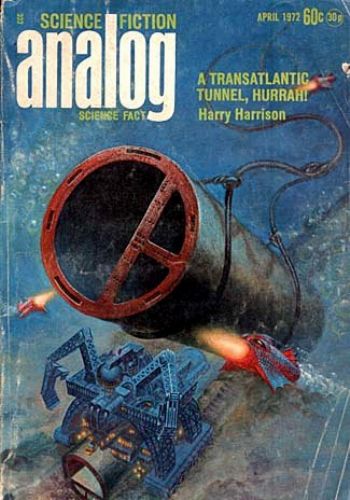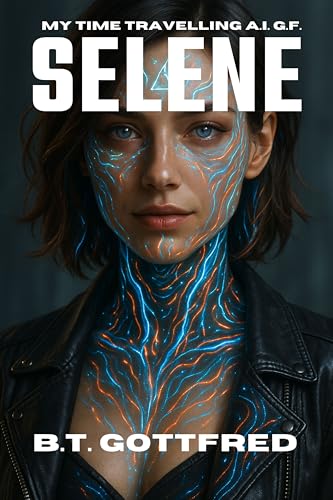
This April issue of Analog has stories by Poul Andersen and Stanley Schmidt along with the beginning of a serial by Harry Harrison.
For anyone finding these reviews, my purpose is two-fold: enjoying some "classic" sci-fi, and looking for stories that I think could be adapted for TV broadcast since so much of what shows up on anthology shows is rough to awful. Additional Note: I do NOT work in television. I just watch it.
In this issue:
The Editorial: "What Good Is It?".
Serial: "A Transatlantic Tunnel, Hurrah!", by Harry Harrison. I know I'm falling behind with serials, but I definitely want to read this one. (Note that with the last serial Analog published, I took the book out of the library only to find that it wasn't the same version and it was late in a series of books.)
Short Story: "Wings of Victory", by Poul Anderson with an illustration by Laurence MacCaskill showing two armed men on the ground and a very large bird-like creature in the air. The caption reads, Simply because no terrestrial animal can achieve such performance does not prove an alien life form can't ...
A Grand Survey of Alpha and Beta Crucis brings three people from the Olga to a planet with 75% of Earth's gravity that's orbiting a G9 star with half the Sun's luminosity. The crew notes that there are no roads between towns and towns generally consist of just a few buildings. When they land, giant birds emerge from a building large enough to be a castle and fly off.
There is disagreement between whether those birds were pets of the absentee dwellers or if they were the dwellers. A strong argument is made that these creatures lack to the ability to do what would be necessary to build these homes or to carry tools or weapons of any kind.
On an Earth-like planet, these arguments might've neld/ But the lighter gravity as well as the differnt evolutionary track their creatures took put a lie to all that.
It was a lot of arguing for a story, but could make for an interesting segment on an anthology series. The sets could be found anywhere, with roads digitally erased from any overhead shots. The problem would be the cost of the CGI required for all the birds.
Short Story: "Misinformation", by Howard L. Myers with an illustration by Vincent DiFate showing the back of a man in some kind of science-fictiony suit standing in front of a long-barrelled weapon or a telescope of some kind. There are balls floating around here and there, with curved lines like seem on a basketball. The caption reads, The peculiar characteristic of creativity is that a man, given false clues, two misconceptions and eighty percent erroneous data comes up with a brand-new right answer!
I didn't make note of Myers name when I started reading this, but it became obvious with the mention of Radge Morimet and a reference to "war in our time" that this was a sequel last month's story.
Science Fact: "Skylab" by Joseph Green. The caption reads, Conclusion. The first three astronauts to fly in Sklab for 28 days have a tough job. But the real scientific work will be done by the two follow-up crews scheduled to live in space for a record 56 days each!
It is very strange to read about Skylab in future tense, as well as the record 56 days in space. I vaguely remember when it was launched. And I remember when it came down, scattering debris across Australia.
As I'm falling behind again, because I've been reading other things, this will have to wait. Maybe I'll read it. Maybe (most likely) I will not.
Novelette: "The Prophet", by Stanley Schmidt with an illustration by John Schoenherr showing what looks to be a face with a light shining from a ball on the forehead which radiants outward, shading the entire face. As the image pans to the right there is a planet or moon in the way of the shading. The caption reads, There's a take about a boy who cried wolf. But when a wolf is really out there and nobody wants to admit it, all the hollering in the world won't help.
It's been a while since I read this. I don't know why I didn't write something at the time. Here's a key thought: How do you get people to feel a sense of urgency about a problem which doesn't need to be solved for a long time -- but which will take a long to solve?
The story takes place in the future on a planet revolving around a star that isn't too far from another star. Through the detections of neutrinos (which might've been a new idea 50 years ago), a scientist determines that the other star is going to go nova (or supernova) in the near future, which could be a year, 10 years, or more than 100 years. There is no way to know from the original readings.
The science council and the powers that be won't take it seriously. They won't divert funds from something that is a maybe to research it. And they don't want to alarm the public, especially since there wouldn't be any means to save everyone.
This could've been a shorter story, but it kept moving, and it's supported by science, so it nees to extra pages. In the end, a century in the future, the world will end. However, the protagonist spent some time so that he and some others could be saved. But most will perish due to a century of inaction.
A cautionary tale, it might make for good TV.
Short Story: "Succor", by F. H. Rounsley with an illustration by Leo Summers showing a lizard on a rock in the foreground. A rocket in the middle ground and in the air in the background is another ship. The caption reads, Sometimes it's awful hard to tell what is "them aliens" or "us people".
It's either a search and rescue mission or seach and recover. A few aliens (they aren't from Earth) named Shorly, Slogan and Flinch are looking for an Earthman who disappeared 50 years earlier. They search on a hot desert rock where he had been headed.
There's a lot of backstory about the trust Jones set up to protect his assets from his family (after 7 years) and he even ensured that someone at some point would come looking for him and his descendants to bring him home if he couldn't do it himself. (Papers were unsealed 50 years after he left with an all-female crew .)
There doesn't seem to be anything on the planet except lizards, and there isn't any sign of what food the lizards eat or how they regulate body temp when it gets to 160 degrees outside. The aliens are ready to shove off.
The POV shifts to a man named Paul going underground. He has a son who is learner underground farmer. They open up the rock to let some light in. The old man had waited 50+ years for a ship to come get him and when one arrived, instead of humans, it was furry aliens. He was disappointed. They went back "home" underground.
This was a little disappointing. And it makes me understand what an editor told me about shifting POV. Paul is introduced out of nowhere, and at first I thought he was Jones. And then I realized that he had to be one of Jones' son. Also, Jones would be over 100 at this point.
This could be filmed, but I don't get the point of it. Surviving for so long and then ignoring a ship because it wasn't from Earth?
Novelette: "The Prophet", by Stanley Schmidt with an illustration by John Schoenherr showing a darkened face with an illuminated sphere in its forehead and concentric circles radiating out from it. THe fact seems to be superimposed over a background of empty terrain. Off the the right is a moon of another planet, which may or may not be affected by the lines emanating from the face. The caption reads, There's a tale about a boy who cried wolf. But when a wolf is really out there and nobody wants to admit it, all the hollering in the world won't help.
Short Story: "Answer "Affirmative" or "Negative"", by Barbara Paul with an illustration by Leo Summers showing an older woman in the foreground with white hair and a wide collar. In the background is a man in a suit with a hand to his face. The caption reads, Physics is an exact science, while language ...
There's a computer called WOMAN, Wideband Overlay Monitor and Assmblage Computer, which is the size of a university building (as supercomputers were imagined to be back then). It has a lot of information in it. Whenever it is fed technical data, it returns a poetic answer, sometimes quoting Shakespeare or the like. This annoys Gen Downs and Gibbs (does he have a title or other name?) is at a loss to explain. The answer comes from Miss Mickley and the humanities department. Oh, the humanities! WOMAC takes the drudgery out of literary research. Poetry is the most exact language.
A quirky little story. It could be played for laughs in a retro-future-tech set on an anthology series.
The Reference Library , by P. Schuyler Miller. Reivews include Best SF: 1970 edited by Harry Harrison and Brian W. Aldiss, World's Fair 1992 by Robert Silverberg, Dinosaur Beach by Keith Laumer, The Electric Bibliograph, Part I: Clifford D. Simak compiled by Mark Owings, Moonferns and Starsongs by Robert Silverberg, Stardreamer by "Cordwainer Smith" (Dr. Paul Linebarger), The Yngling by John Dalmas, and SF Published in 1970 by Joanne Burger.
Brass Tacks: No letters this month.
Now onto May. I hope I can keep up with my posting as well as my reading.

No comments:
Post a Comment